NCERT Exemplar: Aldehydes, Ketones & Carboxylic Acids | Chemistry Class 12 - NEET PDF Download
| Table of contents |

|
| Multiple Choice Questions -I |

|
| Multiple Choice Questions -II |

|
| Short Answer Type Questions |

|
| Matching Type Questions |

|
| Assertion and Reason Type Questions |

|
| Long Answer Type Questions |

|
Multiple Choice Questions -I
Q.1. Addition of water to alkynes occurs in an acidic medium and in the presence of Hg2+ ions as a catalyst. Which of the following products will be formed by the addition of water to but-1-yne under these conditions?
(1) (2)
(2)  (3)
(3) (4)
(4) Ans. (2)
Ans. (2)
Solution.
Q.2. Which of the following compounds is most reactive towards nucleophilic addition reactions?
(1) (2)
(2) (3)
(3)  (4)
(4) Ans. (1)
Ans. (1)
Solution.
CH3CHO is most reactive towards nucleophilic addition reactions. Carbonyl compounds are polar with a positive charge on carbon atoms which is attacked by nucleophiles. Two electron-releasing alkyl groups in ketones make carbon less electron-deficient than aldehydes. Benzene ring exhibits + R-effect which thereby decreases the ease of nucleophilic addition reaction in benzaldehyde and acetophenone. Hence the reactivity order is
Q.3. The correct order of increasing acidic strength is _________.
(1) Phenol < Ethanol < Chloroacetic acid < Acetic acid
(2) Ethanol < Phenol < Chloroacetic acid < Acetic acid
(3) Ethanol < Phenol < Acetic acid < Chloroacetic acid
(4) Chloroacetic acid < Acetic acid < Phenol < Ethanol
Ans. (3)
Solution.
Phenol is more stable than alcohol due to the formation of a more stable conjugate base after the removal of H+ from phenol. Whereas carboxylic acid is more acidic than phenol due to the formation of a more stable conjugate base after removal of H+ as compared to phenol.
Whereas carboxylic acid is more acidic than phenol due to the formation of a more stable conjugate base after removal of H+ as compared to phenol. Chloroacetic acid is more acidic than acetic acid due to the presence of an electron-withdrawing chlorine group attached to the α-carbon of carboxylic acid.
Chloroacetic acid is more acidic than acetic acid due to the presence of an electron-withdrawing chlorine group attached to the α-carbon of carboxylic acid.
Q.4. Compound can be prepared by the reaction of ________.
can be prepared by the reaction of ________.
(1) Phenol and benzoic acid in the presence of NaOH
(2) Phenol and benzoyl chloride in the presence of pyridine
(3) Phenol and benzoyl chloride in the presence of ZnCl2
(4) Phenol and benzaldehyde in the presence of palladium
Ans. (2)
Solution.
C6H5OCOC6H5 can be prepared by the reaction of phenol and benzoyl chloride in the presence of pyridine.
Q.5. The reagent which does not react with both, acetone and benzaldehyde is
(1) Sodium hydrogen sulphite
(2) Phenyl hydrazine
(3) Fehling’s solution
(4) Grignard reagent
Ans. (3)
Solution.
Fehling’s solution oxidizes aliphatic aldehydes very easily but does not react with acetone and benzaldehyde.
Q.6. Cannizaro’s reaction is not given by __________.
(1) (2)
(2) (3) HCHO
(3) HCHO
(4) CH3CHO
Ans. (4)
Solution.
CH3CHO will not give Cannizzaro’s reaction because it contains a-hydrogen while other three compounds have no a-hydrogen. Hence, they will give Cannizzaro’s reaction.
Q.7. Which product is formed when the compound is treated with a concentrated aqueous KOH solution?
is treated with a concentrated aqueous KOH solution?
(1) (2)
(2) (3)
(3) (4)
(4)
Ans. (2)
Solution.
Benzaldehyde has no a-hydrogen. So, on reaction with aqueous KOH solution, it undergoes Cannizzaro’s reaction. One molecule of aldehyde is reduced and the other is
Q.8. The structure of ‘A’ and type of isomerism in the above reaction are respectively.
The structure of ‘A’ and type of isomerism in the above reaction are respectively.
(1) Prop–1–en–2–ol, metamerism
(2) Prop-1-en-1-ol, tautomerism
(3) Prop-2-en-2-ol, geometrical isomerism
(4) Prop-1-en-2-ol, tautomerism
Ans. (4)
Solution.
Q.9. Compounds A and C in the following reaction are __________.
(1) Identical
(2) Positional isomers
(3) Functional isomers
(4) Optical isomers
Ans. (2)
Solution.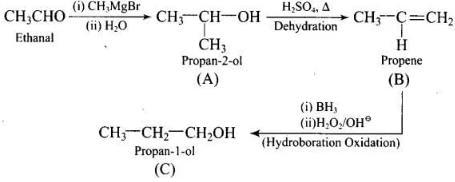
 Q.10. Which is the most suitable reagent for the following conversion?
Q.10. Which is the most suitable reagent for the following conversion? (1) Tollen’s reagent
(1) Tollen’s reagent
(2) Benzoyl peroxide
(3) I2 and NaOH solution
(4) Sn and NaOH solution
Ans. (3)
Solution.
Q.11. Which of the following compounds will give butanone on oxidation with an alkaline KMnO4 solution?
(1) Butan-1-ol
(2) Butan-2-ol
(3) Both of these
(4) None of these
Ans. (2)
Solution. Q.12. In Clemmensen Reduction carbonyl compound is treated with _____________.
Q.12. In Clemmensen Reduction carbonyl compound is treated with _____________.
(1) Zinc amalgam + HCl
(2) Sodium amalgam + HCl
(3) Zinc amalgam + nitric acid
(4) Sodium amalgam + HNO3
Ans. (1)
Solution.
Clemmensen reduction is used to convert the carbonyl group to the CH2 group as follows Zinc amalgam and HCl act as reagents in this reaction.
Zinc amalgam and HCl act as reagents in this reaction.
Multiple Choice Questions -II
Note: In the following questions two or more options may be correct.
Q.13. Which of the following compounds do not undergo aldol condensation?
(1) CH3—CHO
(2) (3)
(3) (4)
(4) Ans. (2 ,4)
Ans. (2 ,4)
Solution. In these compounds, a-hydrogen is absent. So, aldol condensation does not take place in these compounds.
In these compounds, a-hydrogen is absent. So, aldol condensation does not take place in these compounds.
Q.14. Treatment of compound with NaOH solution yields
with NaOH solution yields
(1) Phenol
(2) Sodium phenoxide
(3) Sodium benzoate
(4) Benzophenone
Ans. (2, 3)
Solution. Q.15. Which of the following conversions can be carried out by Clemmensen Reduction?
Q.15. Which of the following conversions can be carried out by Clemmensen Reduction?
(1) Benzaldehyde into benzyl alcohol
(2) Cyclohexanone into cyclohexane
(3) Benzoyl chloride into benzaldehyde
(4) Benzophenone into diphenylmethane
Ans. (2, 4)
Solution.
Clemmensen reduction is used to convert cyclohexanone into cyclohexane and benzophenone into diphenylmethane.

Q.16. Through which of the following reactions number of carbon atoms can be increased in the chain?
(1) Grignard reaction
(2) Cannizaro’s reaction
(3) Aldol condensation
(4) HVZ reaction
Ans. (1, 3)
Solution.
Grignard reagent is used to add number of carbon atom in chain. Aldol condensation involves condensation of aldehydes and ketones with α-hydrogen.
Aldol condensation involves condensation of aldehydes and ketones with α-hydrogen.
Q.17. Benzophenone can be obtained by ____________.
(1) Benzoyl chloride + Benzene + AlCl3
(2) Benzoyl chloride + Diphenyl cadmium
(3) Benzoyl chloride + Phenyl magnesium chloride
(4) Benzene + Carbon monoxide + ZnCl2
Ans. (1, 2)
Solution.

Q.18. Which of the following is the correct representation for intermediate of nucleophilic addition reaction to the given carbonyl compound (A): (1)
(1) (2)
(2) (3)
(3) (4)
(4) Ans. (1, 2)
Ans. (1, 2)
Solution.
Since, the carbonyl compound is a planar molecule hence two orientations of molecule regarding the attack of nucleophiles is possible as follows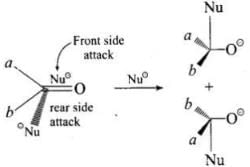
Short Answer Type Questions
Q.19. Why is there a large difference in the boiling points of butanal and butan-1-ol?
Ans. Butan-1 -ol has a higher boiling point (391 K) than butanal due to intermolecular hydrogen bonding between -OH groups of alcohols.
Q.20. Write a test to differentiate between pentan-2-one and pentan-3-one.
Ans. Pentan-2-one having a group forms a yellow ppt. of iodoform with an alkaline solution of iodine (i.e., iodoform test) while pentan-3-one does not.
group forms a yellow ppt. of iodoform with an alkaline solution of iodine (i.e., iodoform test) while pentan-3-one does not.
Q.21. Give the IUPAC names of the following compounds
(1)  (2)
(2) (3)
(3)  (4) CH3—CH== CH—CHO
(4) CH3—CH== CH—CHO
Ans.
(1) 3-Phenylprop-2-en-1 -al
(2) Cyclohexanecarbaldehyde
(3) 3-Oxopentan-l-al
(4) But-2-en-l-al
Q.22. Give the structure of the following compounds.
(1) 4-Nitropropiophenone
(2) 2-Hydroxycyclopentanecarbaldehyde
(3) Phenyl acetaldehyde
Ans.
(1)
4-Nitropropiophenone
(2) 2-Hydroxycyclopentanecarbaldehyde
2-Hydroxycyclopentanecarbaldehyde
(3) Phenyl acetaldehyde
Phenyl acetaldehyde
Q.23. Write the IUPAC names of the following structures.
(1) (2)
(2) (3)
(3) Ans.
Ans.
(1) Ethane-1,2-dial
(2) Benzene-1, 4-dicarbaldehyde
(3) 3-Bromobenzaldehyde
Q.24. Benzaldehyde can be obtained from benzal chloride. Write reactions for obtaining benzal chloride and then benzaldehyde from it.
Ans.
Q.25. Name the electrophile produced in the reaction of benzene with benzoyl chloride in the presence of anhydrous AlCl3. Name the reaction also.
Ans.
Q.26. Oxidation of ketones involves carbon-carbon bond cleavage. Name the products formed on oxidation of 2, 5-dimethylhexan-3-one.
Ans.

Q.27. Arrange the following in decreasing order of their acidic strength and give a reason for your answer.
CH3CH2OH, CH3COOH, ClCH2COOH, FCH2COOH, C6H5CH2COOH
Ans. FCH2COOH > ClCH2COOH > C6H5CH2COOH > CH3COOH > CH3CH2OH
[This is due to the -I effect and acidic strength increases proportionately with the increase in electronegativity.
(i.e., F > Cl > C6H5 > H).
Further CH3COOH is a much stronger acid than CH3CH2OH because CH3COO– ion that has left after the loss of proton is stabilised by resonance but CH3CH2O– does not.]
Q.28. What product will be formed on reaction of propanal with 2-methylpropanal in the presence of NaOH? What products will be formed? Write the name of the reaction also.
Ans. (1)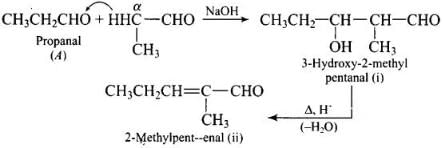 (2)
(2)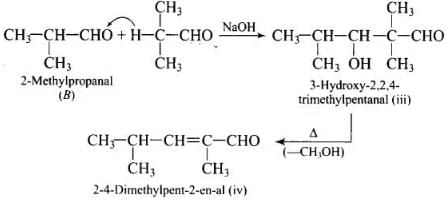
 It is cross-aldol condensation.
It is cross-aldol condensation.
Q.29. Compound ‘A’ was prepared by oxidation of compound ‘B’ with alkaline KMnO4. Compound ‘A’ on reduction with lithium aluminum hydride gets converted back to compound ‘B’. When compound ‘A’ is heated with compound B in the presence of H2SO4 it produces fruity smell of compound C to which family the compounds ‘A’, ‘B’ and ‘C’ belong to?
Ans. ‘A’ is carboxylic acid (R -COOH), ‘B' is an alcohol (R - CH2OH) and ‘C’ an ester (RCH2 - COOR)


Q.30. Arrange the following in decreasing order of their acidic strength. Explain the arrangement.
C6H5COOH, FCH2COOH, NO2CH2COOH
Ans. NO2CH2COOH > FCH2COOH > C6H5COOH
-NO2 and -F groups are electron-withdrawing groups. Out of the two -NO2 has a greater electron-withdrawing effect. C6H5-group has an electron denoting effect.
Q.31. Alkenes and carbonyl compounds
and carbonyl compounds , both contain a π bond but alkenes show electrophilic addition reactions whereas carbonyl compounds show nucleophilic addition reactions. Explain.
, both contain a π bond but alkenes show electrophilic addition reactions whereas carbonyl compounds show nucleophilic addition reactions. Explain.
Ans. The Carbonyl group is polar in nature. Due to the larger electronegativity of oxygen as compared to carbon, carbon acquires a partial positive charge while O acquires a partial negative charge. Because of slight positive charge on C atom, it is attacked by nucleophiles and, therefore, undergoes nucleophilic addition reaction.
Because of slight positive charge on C atom, it is attacked by nucleophiles and, therefore, undergoes nucleophilic addition reaction.
Ethylenic double bond is a non-polar bond and is a source of electrons. Therefore, it is attacked by electrophiles and undergoes electrophilic addition reactions.
Q.32. Carboxylic acids contain carbonyl group but do not show the nucleophilic addition reaction like aldehydes or ketones. Why?
Ans. It is due to resonance as shown below. The partial positive charge on the carbonyl carbon atom is reduced Similarly, a carbonyl group of aldehydes and ketones may be regarded as the resonance hybrid of the following structures.
Similarly, a carbonyl group of aldehydes and ketones may be regarded as the resonance hybrid of the following structures. The carbonyl carbon of the carboxylic group is less electrophilic than carbonyl carbon in aldehydes and ketones and hence nucleophilic addition reactions of aldehydes and ketones do not takes place with carboxylic acids.
The carbonyl carbon of the carboxylic group is less electrophilic than carbonyl carbon in aldehydes and ketones and hence nucleophilic addition reactions of aldehydes and ketones do not takes place with carboxylic acids.
Q.33. Identify the compounds A, B and C in the following reaction. Ans.
Ans.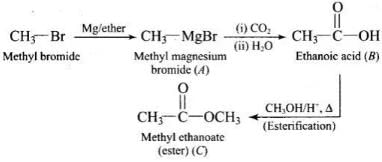
Q.34. Why are carboxylic acids more acidic than alcohols or phenols although all of them have a hydrogen atom attached to an oxygen atom (—O—H)?
Ans. The aliphatic carboxylic acids are stronger acids than alcohols and phenols. The difference in the relative acidic strengths can be understood if we compare the resonance hybrids of carboxylate ion and ethoxide phenoxide ion.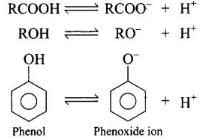 The resonance hydrids may be represented as:
The resonance hydrids may be represented as: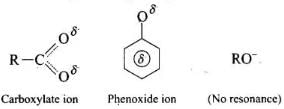 The resonance hybrids may be represented as:
The resonance hybrids may be represented as:
Carboxylate ion Phenoxide ion (No resonance)
The electron charge on the carboxylate ion is more dispersed in comparison to the phenate ion since there are two electronegative oxygen atoms in carboxylate ion as compared to only one oxygen atom in phenoxide ion. In other words, the carboxylate ion is relatively more stable as compared to phenate ion. Thus, the release of H+ ion from carboxylic acid is comparatively easier or it behaves as a stronger acid than phenol.
Q.35. Complete the following reaction sequence. Ans.
Ans.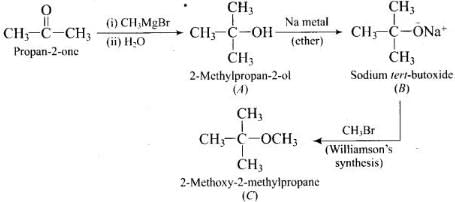
Q.36. Ethylbenzene is generally prepared by acetylation of benzene followed by reduction and not by direct alkylation. Think of a possible reason.
Ans. Preparation of ethylbenzene from acylation of benzene and reduction can be shown as
Q.37. Can Gatterman-Koch reaction be considered similar to Friedel Craft’s acylation? Discuss.
Ans. Gattermann-Koch reaction is formylation (introduction of -CHO group) to the benzene nucleus.
Friedel-Crafts acylation reaction is introduction of RCO— group in the benzene ring.

In Friedel-Crafts acylation reactions, the benzene is treated with an acid chloride in the presence of anhydrous AlCl3. So, the Gattermann-Koch reaction can be considered similar to the Friedel-Crafts acylation reaction.
Matching Type Questions
Note : Match the items of Column I and Column II in the following questions.
Q.38. Match the common names given in Column I with the IUPAC names given in Column II.
| Column I (Common names) | Column II (IUPAC names) |
| (i) Cinnamaldehyde | (a) Pentanal |
| (ii) Acetophenone | (b) Prop-2-enal |
| (iii) Valeraldehyde | (c) 4-Methylpent-3-en-2-one |
| (iv) Acrolein | (d) 3-Phenylprop-2-enal |
| (v) Mesityl oxide | (e) 1-Phenylethanone |
Ans.(i → d), (ii → e), (iii → a), (iv → b), (v → c)
| (Common names) | Structure | (IUPAC names) |
| (i) Cinnamaldehyde |  | 3-Phenylprop-2-enal |
| (ii) Acetophenone |  | 1-Phenylethanone |
| (iii) Valeraldehyde |  | Pentanal |
| (iv) Acrolein |  | Prop-2-enal |
| (v) Mesityl oxide |  | 4-Methylpent-3-en-2-one |
Q.39. Match the acids given in Column I with their correct IUPAC names given in Column II.
| Column I (Acids) | Column II (IUPAC names) |
| (i) Phthalic acid | (a) Hexane-1,6-dioic acid |
| (ii) Oxalic acid | (b) Benzene-1,2-dicarboxylic acid |
| (iii) Succinic acid | (c) Pentane-1,5-dioic acid |
| (iv) Adipic acid | (d) Butane-1,4-dioic acid |
| (v) Glutaric acid | (e) Ethane-1,2-dioic acid |
Ans. (i → b), (ii → e), (iii → d), (iv → a), (v → c)
| Acids | IUPAC names | Structure |
| (i) Phthalic acid | Benzene-1,2-dicarboxylic acid |  |
| (ii) Oxalic acid | Ethane-1,2-dioic acid |  |
| (iii) Succinic acid | Butane-1,4-dioic acid |  |
| (iv) Adipic acid | Butane-1,4-dioic acid |  |
| (v) Glutaric acid | Pentane-1,5-dioic acid |  |
Q.40. Match the reactions given in Column I with the suitable reagents given in Column II.
| Column I (Reactions) | Column II (Reagents) |
| (i) Benzophenone → Diphenylmethane | (a) LiAlH4 |
| (ii) Benzaldehyde → 1-Phenylethanol | (b) DIBAL—H |
| (iii) Cyclohexanone → Cyclohexanol | (c) Zn(Hg)/Conc. HCl |
| (iv) Phenyl benzoate → Benzaldehyde | (d) CH3MgBr |
Ans. (i → c), (ii → d), (iii → a), (iv → b)
(i) (ii)
(ii)
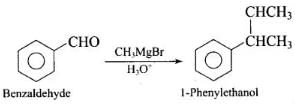 (iii)
(iii) (iv)
(iv)
Q.41. Match the example given in Column I with the name of the reaction in Column II.
| Column I (Example) | Column II (Reaction) |
(i)  | (a) Friedel-Crafts acylation |
(ii)  | (b) HVZ reaction |
(iii)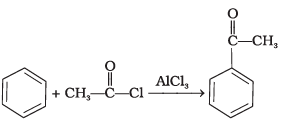 | (c) Aldol condensation |
(iv) | (d) Cannizaro’s reaction |
(v) | (e) Rosenmund’s reduction |
(vi)  | (f) Stephen’s reaction |
Ans. (i → e), (ii → d), (iii → a), (iv → b), (v → f), (vi → d)
Assertion and Reason Type Questions
Note : In the following questions a statement of assertion followed by a statement of reason is
given. Choose the correct answer out of the following choices.
Q.42. Assertion: Formaldehyde is a planar molecule.
Reason: It contains sp2 hybridised carbon atom.
(1) Assertion and reason both are correct and reason is correct explanation of assertion.
(2) Assertion and reason both are wrong statements.
(3) Assertion is correct statement but reason is wrong statement.
(4) Assertion is wrong statement but reason is correct statement.
(5) Assertion and reason both are correct statements but reasson is not correct explanation of assertion.
Ans. (1)
Solution.
Formaldehyde is a planar molecule because it contains sp2 hybridized carbon atom.
Q.43. Assertion : Compounds containing —CHO group are easily oxidised to corresponding carboxylic acids.
Reason : Carboxylic acids can be reduced to alcohols by treatment with LiAlH4.
(1) Assertion and reason both are correct and reason is correct explanation of assertion.
(2) Assertion and reason both are wrong statements.
(3) Assertion is correct statement but reason is wrong statement.
(4) Assertion is wrong statement but reason is correct statement.
(5) Assertion and reason both are correct statements but reasson is not correct explanation of assertion.
Ans. (5)
Solution.
Due to electron withdrawing nature of -C = O group, C — H bond in aldehydes is weak and thus can be easily oxidized to the corresponding carboxylic acids even with mild oxidizing agents like Fehling’s solution and Tollens reagents.
Q.44. Assertion : The α-hydrogen atom in carbonyl compounds is less acidic.
Reason : The anion formed after the loss of α-hydrogen atom is resonance stabilised.
(1) Assertion and reason both are correct and reason is correct explanation of assertion.
(2) Assertion and reason both are wrong statements.
(3) Assertion is correct statement but reason is wrong statement.
(4) Assertion is wrong statement but reason is correct statement.
(5) Assertion and reason both are correct statements but reasson is not correct explanation of assertion.
Ans. (4)
Solution.
The a-hydrogen atom in carbonyl compounds is more acidic.
Q.45. Assertion : Aromatic aldehydes and formaldehyde undergo Cannizaro reaction.
Reason : Aromatic aldehydes are almost as reactive as formaldehyde.
(1) Assertion and reason both are correct and reason is correct explanation of assertion.
(2) Assertion and reason both are wrong statements.
(3) Assertion is correct statement but reason is wrong statement.
(4) Assertion is wrong statement but reason is correct statement.
(5) Assertion and reason both are correct statements but reasson is not correct explanation of assertion.
Ans. (3)
Solution.
Aromatic aldehydes and formaldehyde do not contain a-hydrogen and thus undergo Cannizzaro’s reaction. Formaldehyde is more reactive than aromatic aldehydes.
Q.46. Assertion : Aldehydes and ketones, both react with Tollen’s reagent to form silver mirror.
Reason : Both, aldehydes and ketones contain a carbonyl group.
(1) Assertion and reason both are correct and reason is correct explanation of assertion.
(2) Assertion and reason both are wrong statements.
(3) Assertion is correct statement but reason is wrong statement.
(4) Assertion is wrong statement but reason is correct statement.
(5) Assertion and reason both are correct statements but reasson is not correct explanation of assertion.
Ans. (4)
Solution.
Both aldehyde and ketones have carbonyl group but only aldehydes react with Tollen’s reagent to give silver mirror.
Long Answer Type Questions
Q.47. An alkene ‘A’ (Mol. formula C5H10) on ozonolysis gives a mixture of two compounds ‘B’ and ‘C’. Compound ‘B’ gives positive Fehling’s test and also forms iodoform on treatment with I2 and NaOH. Compound ‘C’ does not give Fehling’s test but forms iodoform. Identify the compounds A, B and C. Write the reaction for ozonolysis and formation of iodoform from B and C.
Ans. Compound B gives positive Fehling’s test. It shows that it is an aldehyde and gives iodoform test which shows it has -COCH3 group. Compounds C is a ketone because it does not give Fehling’s test but gives iodoform test which shows it also has -COCH3 groups.
Hence compound A is (i)
(i) Other isomer of (A) will not give products corresponding to the given test.
Other isomer of (A) will not give products corresponding to the given test.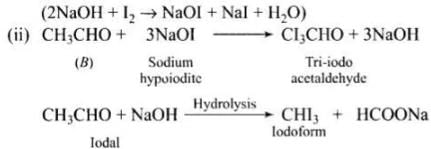
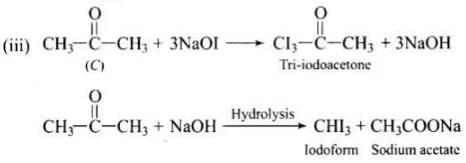
Q.48. An aromatic compound ‘A’ (Molecular formula C8H8O) gives a positive 2, 4-DNP test. It gives a yellow precipitate of compound ‘B’ on treatment with iodine and sodium hydroxide solution. Compound ‘A’ does not give Tollen’s or Fehling’s test. On drastic oxidation with potassium permanganate it forms a carboxylic acid ‘C’ (Molecular formula C7H6O2), which is also formed along with the yellow compound in the above reaction. Identify A, B and C and write all the reactions involved.
Ans. Molecular formula of compound is C8HgO. As ‘A’ does not give Tollens’ or Fehling’s test. It must be a ketone. It gives positive test with 2, 4-DNP and iodoform test. It means it is methyl ketone.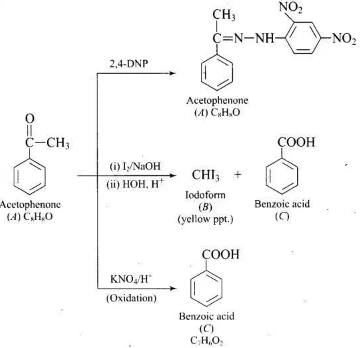
Q.49. Write down functional isomers of a carbonyl compound with molecular formula C3H6O. Which isomer will react faster with HCN and why? Explain the mechanism of the reaction also. Will the reaction lead to the completion with the conversion of whole reactant into product at reaction conditions? If a strong acid is added to the reaction mixture what will be the effect on concentration of the product and why?
Ans. C3H6O will have following isomer. Compound I will react faster with HCN due to less steric hindrance and greater positive charge on carbon atom of carbonyl group. Two methyl groups increase electron density on carbonyl carbon in compounds II hence the rate of nucleophilic attack is less.
Compound I will react faster with HCN due to less steric hindrance and greater positive charge on carbon atom of carbonyl group. Two methyl groups increase electron density on carbonyl carbon in compounds II hence the rate of nucleophilic attack is less.
Mechanism of the reaction: The reaction will not lead to completion since it is a reversible reaction, hence equilibrium is established.
The reaction will not lead to completion since it is a reversible reaction, hence equilibrium is established.
If a strong acid is added to reaction mixture, the addition is inhibited because the formation of CN” ions form HCN is prevented.
Q.50. When liquid ‘A’ is treated with a freshly prepared ammoniacal silver nitrate solution, it gives bright silver mirror. The liquid forms a white crystalline solid on treatment with sodium hydrogensulphite. Liquid ‘B’ also forms a white crystalline solid with sodium hydrogen sulphite but it does not give test with ammoniacal silver nitrate. Which of the two liquids is aldehyde? Write the chemical equations of these reactions also.
Ans. Liquid ‘A’ forms a bright silver mirror on treatment with ammoniacal AgNO3 solution, therefore, liquid ‘A’ is an aldehyde.
Liquid B does not give test with ammoniacal AgNO3 solution, therefore, liquid ‘B’ must be a methyl ketone.
Chemical equations for these reactions are:
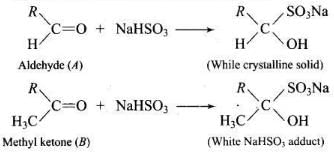

|
75 videos|278 docs|78 tests
|
FAQs on NCERT Exemplar: Aldehydes, Ketones & Carboxylic Acids - Chemistry Class 12 - NEET
| 1. What are aldehydes and ketones? |  |
| 2. How do aldehydes and ketones differ in their chemical properties? |  |
| 3. What are some common uses of aldehydes, ketones, and carboxylic acids? |  |
| 4. How can aldehydes and ketones be distinguished from each other? |  |
| 5. What are carboxylic acids and their importance? |  |















